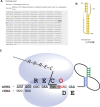Recode-2: new design, new search tools, and many more genes
- PMID: 19783826
- PMCID: PMC2808893
- DOI: 10.1093/nar/gkp788
Recode-2: new design, new search tools, and many more genes
Abstract
'Recoding' is a term used to describe non-standard read-out of the genetic code, and encompasses such phenomena as programmed ribosomal frameshifting, stop codon readthrough, selenocysteine insertion and translational bypassing. Although only a small proportion of genes utilize recoding in protein synthesis, accurate annotation of 'recoded' genes lags far behind annotation of 'standard' genes. In order to address this issue, provide a service to researchers in the field, and offer training data for developers of gene-annotation software, we have gathered together known cases of recoding within the Recode database. Recode-2 is an improved and updated version of the database. It provides access to detailed information on genes known to utilize translational recoding and allows complex search queries, browsing of recoding data and enhanced visualization of annotated sequence elements. At present, the Recode-2 database stores information on approximately 1500 genes that are known to utilize recoding in their expression--a factor of approximately three increase over the previous version of the database. Recode-2 is available at http://recode.ucc.ie.
Figures


References
-
- Namy O, Rousset JP, Napthine S, Brierley I. Reprogrammed genetic decoding in cellular gene expression. Mol. Cell. 2004;13:157–168. - PubMed
-
- Farabaugh PJ. Programmed translational frameshifting. Annu. Rev. Genet. 1996;30:507–528. - PubMed
-
- Baranov PV, Gesteland RF, Atkins JF. Recoding: translational bifurcations in gene expression. Gene. 2002;286:187–201. - PubMed
-
- Atkins JF, Wills NM, Loughran G, Wu CY, Parsawar K, Ryan MD, Wang CH, Nelson CC. A case for “StopGo”: reprogramming translation to augment codon meaning of GGN by promoting unconventional termination (Stop) after addition of glycine and then allowing continued translation (Go) RNA. 2007;13:803–810. - PMC - PubMed

